
The Ravi River is a transboundary river crossing northwestern India and eastern Pakistan. It is one of five rivers associated with the Punjab region.

Pinus gerardiana, commonly known as the chilghoza pine or neja, is a pine native to the northwestern Himalayas in Afghanistan, northern Pakistan, Waziristan and northwestern India, growing at elevations of 1,800–3,350 metres (5,910–10,990 ft). It often occurs in association with Cedrus deodara, and Pinus wallichiana.

The music of Himachal Pradesh includes many kinds of folk songs from the area, many of which are sung without accompaniment.
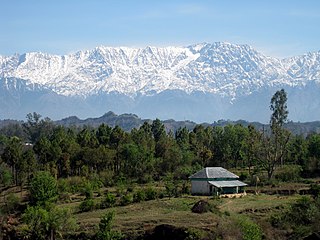
Dhauladhar is a mountain range which is part of a lesser Himalayan chain of mountains. It rises from the Shivalik hills, to the north of Kangra and Mandi. Dharamsala, the headquarters of Kangra district and the winter capital of Himachal Pradesh, lies on its southern spur in the Kangra Valley. Chamba lies to the North of this range.
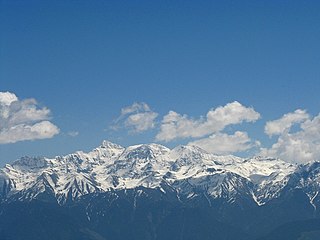
The Pir Panjal Range is a range of mountains in the Lower Himalayan region located in the Western Himalayas of northern Indian subcontinent. It runs southeast to northwest between the Beas and Neelam/Kishanganga rivers, in the Indian state of Himachal Pradesh and Indian-administered union territory of Jammu and Kashmir, with its northwestern end extending into territory administered by Pakistan. The Himalayas show a gradual elevation towards the Dhauladhar and Pir Panjal ranges. Pir Panjal is the largest and westernmost range of the Lesser Himalayas. Near the bank of the Sutlej River, it dissociates itself from the main Himalayan range and forms a divide between the Beas and Ravi rivers on one side and the Chenab on the other. Further west, the Pir Panjal range forms the southwestern boundary of the Kashmir Valley, separating it from the hills of Jammu region, forming a divide between the Jhelum and Chenab rivers.

The state of Himachal Pradesh is spread over an area 55,673 km2 (21,495 sq mi) and is bordered by Jammu and Kashmir and Ladakh on the north, Punjab on the southwest, Haryana on the south, Uttarakhand on the southeast, a small border with Uttar Pradesh in the south, and Tibet on the east. Entire Himachal Pradesh lies in the mountainous Himalaya region, rich in natural resources

Chamba is a town in the Chamba district in the Indian state of Himachal Pradesh. According to the 2001 Indian census, Chamba has a population of 20,312 people. Located at an altitude of 1,006 metres (3,301 ft) above mean sea level, the town is situated on the banks of the Ravi River, at its confluence with the Sal River.
Dalhousie cantonment is a town in Dalhousie, just 50 km from Chamba town in Chamba district in the state of Himachal Pradesh, India.
Himachal Pradesh, although railways and airways serve very limited transport needs, the road network of the state serves the transport needs of the people. Although, the geography of Himachal presents considerable challenge to the development of transport infrastructure, it has the highest road density among all the Hill States of India. Himachal also has 3 airports, 2 narrow gauge rail tracks and couple of other under-construction broad gauge railway tracks, but roads remain the main mode of transport.
Dharwas is the northernmost town of the state of Himachal Pradesh in India. It is located in the Chamba District at an elevation of 8,000 ft (2,400 m) above sea level. Dharwas is the largest and most populated area in the Pangi Valley, and trekking base camps are available for those on the Dalhousie-Kishtwar trekking route.

Sach Pass is a 4,414-metre-high (14,482 ft) mountain pass in Chamba District, Himachal Pradesh, India on the Pir Panjal range of the Himalayas. It is 127 km (79 mi) from the District Headquarters. It connects the Chamba valley with the Pangi valleys of Himachal Pradesh, India. There is a helipad on the ascent towards Sach pass from Bairagarh of Himachal Pradesh.
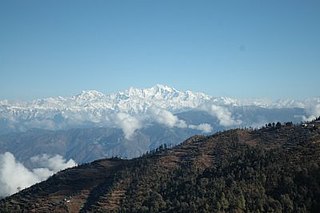
Kanatal is a small village that is a hill station in the state of Uttarakhand, India. Kanatal is 78 km from Dehradun, 38 km from Mussoorie and 18 km from Chamba. It is on the Chamba-Mussoorie road and nearly 300 km from Delhi.
Salooni is the tehsil headquarter and Sub-Division in Chamba district of Himachal Pradesh, India. Salooni is an important regional administrative and economic centre. It has a mini secretariat, SDM office, government senior secondary school, Degree College, community health centre and many other sub-division level important government offices. Salooni falls under Dalhousie legislative constituency. The entrance to the small township has a series of few quaint shops, followed by small ground with an ancient goddess Kali temple at other end.

Paddar, also spelled Padar, is a Sub-District and remote valley in the Kishtwar district of the union territory of Jammu and Kashmir, India. It falls in the Jammu division. It consists of two tehsils namely Machail and Atholi Paddar The valley covers the entire southeastern portion of the Kishtwar district. It borders Zanskar (Ladakh) in the north and east, Pangi in the south and the rest of Jammu and Kashmir in the west. The valley is known for its Sapphire mines. Albeit Sapphires are located in the valley of Paddar in Jammu division, they are known as Kashmiri sapphires which is a misnomer. It lies along the Chandrabhaga river (Chenab) in the Great Himalayas. Paddar is one of the most remote regions of Jammu and Kashmir. There are a number of small valleys within Paddar, such as Machail, Gandhari, Kabban, Ongai, Bhuzunu, Barnaj, Bhuzas, Kijai Nallah, and Dharlang, among others.

The Bodh people, also known as Khas Bhodi, are an ethnic group of Himachal Pradesh, India. They are found in Lahaul tehsil, Lahaul and Spiti district, predominantly in the Bhaga and Chandra valleys, but also to a lesser extent in Pattani valley, Miyar Valley, in the upper reaches of Pangi, Himachal Pradesh and Paddar valley, Jammu and Kashmir. Their religion is predominantly Buddhism with animistic and shaivite practices. Caste wise, they are identified as Rajput, Thakur or Kshetri although caste rules are not as rigid as in the plains. Historically, 3-4 prominent families of the area were accorded the titles of Rana, Wazir or Thakur by the kings of Chamba, Kullu or Ladakh for the purpose of general administration and revenue collection. They have a mix of martial traditions alongside shamanistic and lamaistic beliefs. Certain families/clans used to be significant zamindars/jagirdars. There is a significant cultural and ethnic mixing due to the region passing under the hegemony of rulers of Ladakh, Kullu and Chamba over the last many centuries. The language spoken differs from valley to valley with some dialects being very close to Kumaoni, while others are mixed with Chambyali and Dari. They are progressive, enterprising, honest and were involved in the centuries old India-Tibet-Nepal trading routes. Organized into family groups/clans with clan names ending in the suffix "-pa" similar to the "-ta" suffix found in the family/clan names of the Simla area.
The Pangwala is a tribal community predominant in the Pangi valley of Chamba district in Himachal Pradesh.
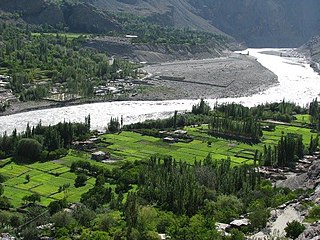
Siksa is a village in the sub division Chorbat Valley, Ghanche District of Gilgit-Baltistan, lying 150 kilometres (93 mi) east of Skardu, near the border of Pakistan and India at an elevation of 2,725 metres (8,940 ft).
Killar or Kilar is a town in Himachal Pradesh, India. It is headquarters of Pangi Tehsil in Chamba district.
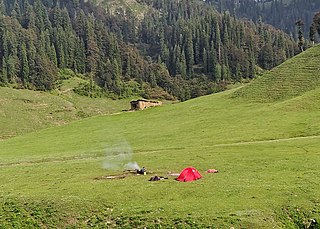
Bhal Padri is a hill station situated above a group of small valleys covered with a dense forest located in the Changa, Bhalessa. area of Doda district. It borders Padri Pass, Bhaderwah at a distance of 4 kilometres (2.5 mi) northeast. Rivulets and streams flow through this valley.

Acer pentapomicum, the Punjab maple, is a species of flowering plant in the genus Acer, native to Afghanistan, Pakistan, Central Asia and the western Himalaya. Preferring to grow 1,900 to 2,800 m above sea level, it is a member of the upper canopy in forested areas where it is found.




















